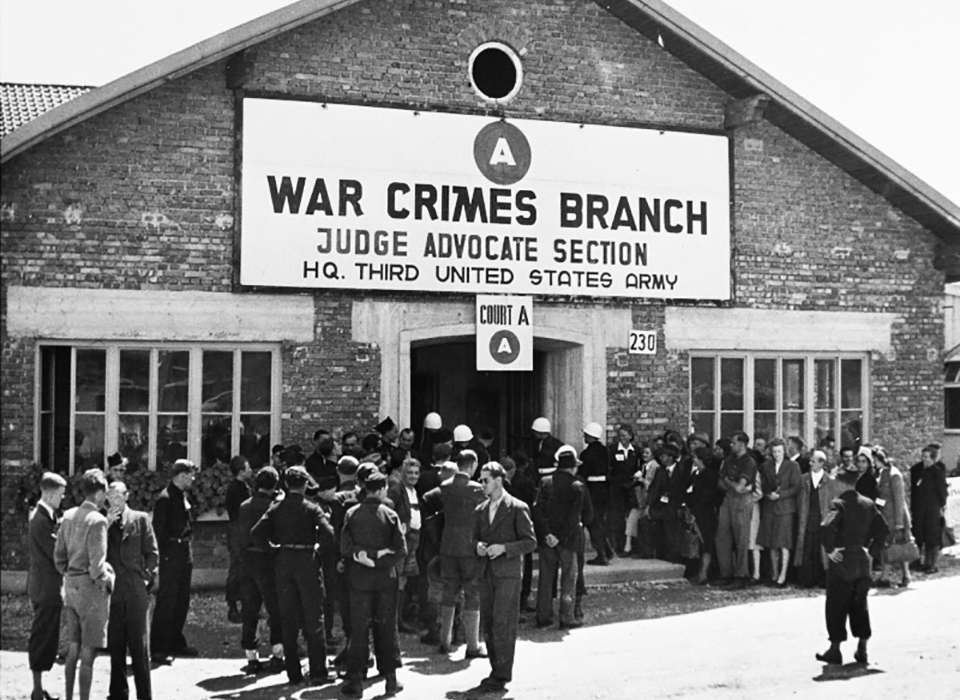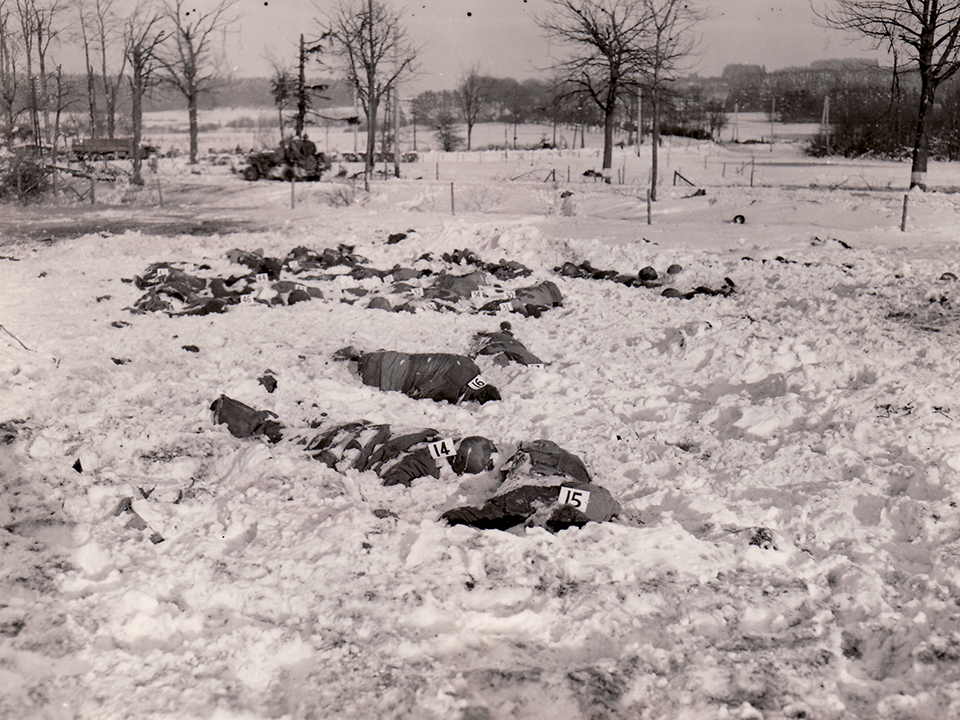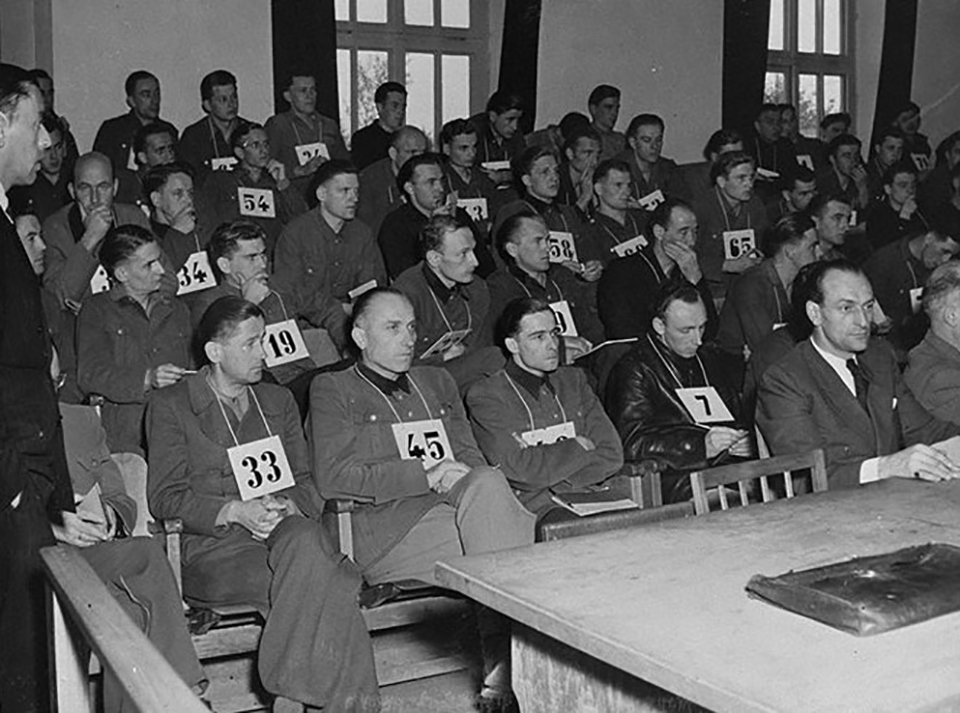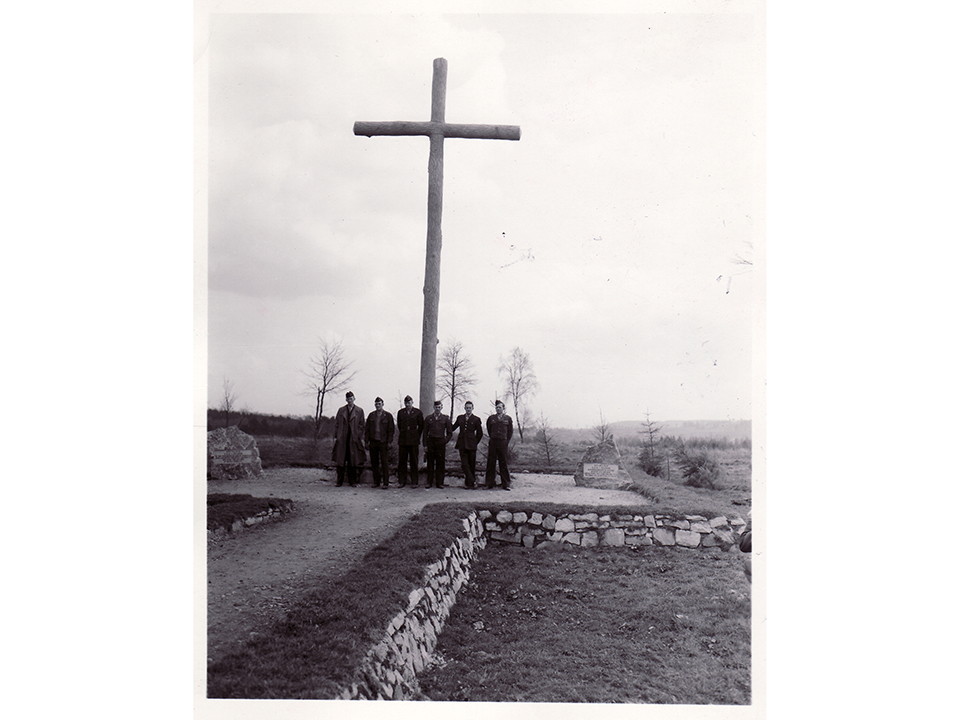Top Image: Spectators and US Army military police waiting outside of the building where 74 SS men will be sentenced on July 16, 1946. United States Holocaust Memorial Museum, courtesy of National Archives and Records Administration, College Park.
In the first postwar spring, Dachau, the first Nazi concentration camp and site of terror for more than 10 years, became the stage for an American courtroom. Beyond the four-nation process of the International Military Tribunal at Nuremberg, occupying forces, including the United States, also held individual military tribunals in their respective zones. The trials presided over by the US Army took place at Dachau from November 1945 to December 1947. The defendants included a wide range of individuals—high-ranking members of the German military, Nazi officials, concentration camp personnel, and also civilians. They were accused of war crimes against Allied POWs and crimes perpetrated against Allied civilians and prisoners of war in concentration camps, including Dachau.
One component of the Dachau Trials, the Malmedy Massacre Trial, took place over two months from May to July 1946 and centered on crimes by the Waffen SS against American POWs and Belgian civilians. The Malmedy Massacre was a well-documented and publicized murder of unarmed American POWs by the 1st SS during the Battle of the Bulge. On December 17, 1944, elements of the 1st SS Panzer Regiment commanded by Joachim Peiper, captured 113 American soldiers, assembled them in a field and machine-gunned them. Some survived buried under their fellow soldiers or by playing dead, but 84 American POWs were killed.
Their bodies would remain in the field where they were massacred until mid-January when American war crimes investigators recovered their remains and gathered evidence. Survivors who made their way back to Allied lines told of the event and news trickled out to American soldiers and to the American public with stories in Yank, Stars and Stripes, and LIFE Magazine. Survivors like Warren Shmitt and Ted Paluch were interrogated by Allied intelligence and were then sent back to fight despite their traumatic experience.
The murder of prisoners of war at Malmedy was just one of the atrocities committed by Peiper’s SS unit and only one crime considered in the charges which mentioned that his men:
“…did, at or in the vicinity of Malmedy, Honsfeld, Bullingen, Ligneauville, Stoumont, La Gleize, Cheneus, Petit Their, Trois Ponts, Stavelot, Wanne, and Lustre-Bois, all in Belgium, at sundry times between 16 December and 13 January 1945, willfully, deliberately, and wrongfully permit, encourage, aid, abet and participate in the killings, shooting, ill treatment, abuse, and torture of members of the Armed Forces of the United States of America, then at war with the then German Reich, who were then and there surrendered and unarmed prisoners of war in the custody of the then German Reich, the exact names and numbers of such persons being unknown but aggregating several hundred, and of unarmed allied civilian nationals, the exact names and numbers of such persons being unknown.”
The 1946 trial charged 74 SS members for these crimes and included Joachim Peiper, commander of Kampfruppe Peiper, as well as the commander of the 6th Panzer Army, SS-Oberst-Gruppenführer Josef “Sepp” Dietrich. The defendants had been held in various locations since their defeat. Once identified as having been associated with the units responsible for war crimes, the men were interrogated in Schwäbisch Hall, Germany; many were questioned by bilingual US soldiers who had fled Nazi persecution in Europe. Initially, the prisoners were held together and had the opportunity to coordinate stories and strategize defense.
Seven Malmedy survivors testified at the trial, which began on May 16. Belgian civilian witnesses to the murder of unarmed civilians also testified. Members of the SS stated under oath. Much of the testimony was written with nearly 100 sworn statements brought before the court, including confessions and statements by some of the defendants informing on some of their co-defendants. The uniformed defendants sat with numbered identification cards around their necks. Only some were given the opportunity to take the stand. The prosecution argued that the murder of American POWs and others carried out by Peiper and his men was premeditated, the result of Hitler’s orders for a ruthless campaign to inspire fear and terror. The defense maintained that the killings had taken place in the heat of battle.
After the proceedings came to an end, a verdict was delivered on July 16, 1946, convicting all defendants. The American military court at Dachau sentenced 46 members of the Waffen SS, including Joachim Peiper, to death by hanging for crimes committed against Allied POWs. Another 23 were given life imprisonment and the remaining men received sentences between 10 and 20 years.
What happened in the months and years following remains a source of interest and research. The proceedings themselves and the interrogations leading up to the trial became highly publicized, contested, and politicized. The convicted SS men claimed that American interrogators used unlawful methods and even torture and that all of the statements given were coerced. Former chief defense counsel Col. Willis Everett continued to work on behalf of the convicted men, even after returning home and leaving active duty in 1947.
Publicity regarding the trial mounted and the Secretary of the Army responded by organizing a commission to investigate these allegations. The claims of abuse, supported by German veterans, the German populace, and religious organizations who desired the release of war criminals, also had American backers. One member of the commission in particular, Judge Edward Van Roden, propagated the allegations and questioned the validity of the trial. Following this commission, on March 20, 1948, 31 of the death sentences were commuted to life imprisonment, except Peiper and 11 others. Additionally, 13 of the initial 74 were freed, citing insufficient evidence.
The energy behind the abuse allegations was sustained and in 1949, Senate hearings were conducted to investigate. New Senator Joseph McCarthy had an intense interest in the case and obtained special permission to attend the hearings, seeing the Malmedy trial as a chance for the spotlight. A central point of the investigations was the motivation of the interrogators, some of whom were Jews who had fled Europe and had become American soldiers. Defenders of those declared guilty at Dachau argued that the interrogators, especially the Prague-born PhD chief interrogator Lt. William Perl, whose wife had survived Ravensbruck, were out for revenge.
McCarthy, the hearing’s supposed observer, played a leading role, sympathizing with Peiper and the other SS men, aggressively questioning the US interrogators and other witnesses, going so far as to call for Lt. Perl to undergo a lie detector test. In the end, the commission found these claims to be false, the allegations of abuse largely fabricated, but still procedural haziness was discovered and documented, allowing for enough basis to further amend the sentences delivered on July 16, 1946.
By 1951, most of the men were released and the only remaining death sentences, those of Peiper and four others, were commuted. Peiper’s sentence was further reduced in 1954. Both Sepp Dietrich and Joachim Peiper were released from Landsberg prison in 1956. Some would say that justice came for Peiper, 30 years after the trial at Dachau, when he was killed in his home in France on July 13, 1976. The American POWs who were murdered at Malmedy by Peiper’s forces are memorialized at the Baugnez crossroads within sight of the field where they fell.
This article is part of a series commemorating the 75th anniversary of the end of World War II made possible by the Department of Defense.
Kim Guise
Kimberly Guise holds a BA in German and Judaic Studies from the University of Massachusetts Amherst. She also studied at the Universität Freiburg in Germany and holds a masters in Library and Information Science (MLIS) from Louisiana State University. Kim is fluent in German, reads Yiddish, and specializes in the American prisoner-of-war experience in World War II.
Cite this article:
MLA Citation:
APA Citation:
Chicago Style Citation:






![Max Fuchs, New York City cantor, sings as Rabbi Sydney [sic] Lefkowitz, Richmond, VA, conducts the first Jewish services from Germany.](/sites/default/files/styles/max_650x650/public/2025-10/image1.jpg)






